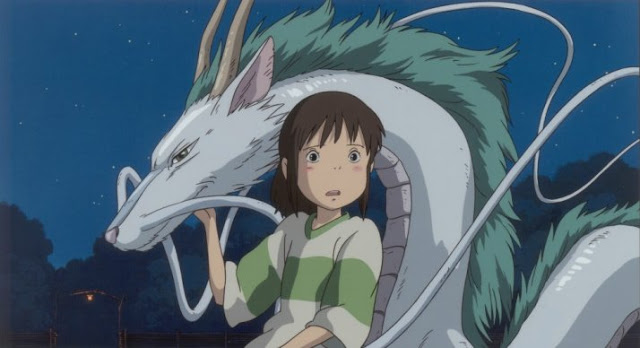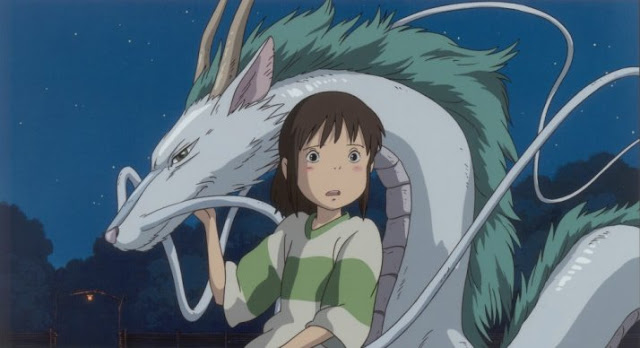 |
Studio Ghibli
|
This is guest post by Eugenia Andino previously appeared at her Web site (in Spanish) and is cross-posted with permission.
The female protagonists in Studio Ghibli films have often been analysed as examples of feminist work; ranging from young women (like Nausicaa or Princess Mononoke) to little girls like Ponyo. The most popular ones, like Chihiro in
Spirited Away, are just on the brink of adolescence. While it is true that there are not many adult women in Studio Ghibli films, there are varied, sympathetic and imaginative portraits of older women, normally in supporting roles.
These older women can be broadly grouped in two types.
The main ones are the wise or nurturing women. The first of them is Obaba in Nausicaa. We first meet her when her family meets Lord Yupa, a visitor, and Obaba interprets for them the local legend of a hero in blue, in a golden field, who will save the Valley. Obaba is brave and strong, if somewhat fatalistic; she dares invaders to kill her, and near the end of the film she seems resigned to the end of the people either by the toxic plants, an attack of giant insects, or foreign invaders. In any case, it is remarkable that for the role of symbolic voice of the Valley culture, the film chooses an old woman rather than a wise man or a warrior.
Princess Mononoke is a film with a similar theme, the conflict created by an industrial city whose prosperity depends on the exploitation of a magical forest. The old, wise woman here is Hii-sama. She tries to placate the possessed boar who bites and curses Ashitaka, without success, and then decides that the protagonist should leave the village and find a cure in the west. Since Ashitaka leaves not to come back, she doesn’t reappear. Again, the character gives richness to the film.
 |
| Dola and her sons |
Sometimes the nurturing woman isn’t a “wise woman” type but simply kind, nurturing, and treated with great sympathy by the story. This is the case with Granny in My Neighbour Totoro, and of the many women in the home where Lisa works in Ponyo. In the forced absence of Satsuki and Mei’s mother because of her illness, Granny (who is not their grandmother but a neighbor, and the grandmother of Satsuki’s friend, Okagi), gives much needed love and attention to the little girl. At the same time, the film never implies that only women should take care of children, as can be seen in the initial scenes of the two little girls housekeeping and bathing with their father, in a rare, realistic and positive example of fatherhood. In this film and in Ponyo, these kinds old neighbors form a community that gives much needed emotional support to little children with loving but busy parents.
But older women’s roles as family caretakers aren’t only surrogate, as we can see in My Neighbors the Yamadas, a sweet “slice of life” piece composed of vignettes. Here we find a family with Takashi, the father, Matsuko the mother, Shige the grandmother, Noburu, a teenage boy, and Nonoko, a little girl. At the end of the film, Noburu jokes that the family works because all three adults are crazy: if any one of them were sensible, the balance would be broken. There’s some truth to this, as there are a number of unresolved tensions among the adults that would be unbearable with only two of them (or if they didn’t love one another very much). The conflict between Granny Shige and her son-in-law is stated early on the film: the property is hers, but he built the house himself. Here and elsewhere, Matsuko doesn’t take sides and tries to stop the fight. On their part, Shige and Matsuko both argue about their (unenthusiastic) housekeeping. Although Shige is often witty and very funny, it’s not all rosy; for example, the melancholy caused by the nearness of her death and the sickness of a friend is the theme of one of the Shorts.
In Spirited Away, we find an example of each category, so let’s introduce the second one: the ambiguous villain or antagonist.
This film has two twin sisters, Yubaba and Zeniba. Their age is doubtful: they look old, but Yubaba has a baby boy. In a way that reminds me slightly of Lady Eboshi in Princess Mononoke, she is, first and foremost, a businesswoman. Her biggest flaw is her greed, but she’s not truly evil. She doesn’t want to cause unnecessary harm, and she always keeps her word, even when she complains that it goes against her interests. Her sister Zeniba starts off as another antagonist, who attacks Haku and transforms Yubaba’s baby boy into a mouse, and then turns out to be grandmotherly and friendly and angry only at her sister for ordering Haku to steal from her. This gives complexity and appeal to the character, showing that “nurturing grandmothers” have their own interests and needs too.
 |
| Hii-Sama dictates Ashitaka’s destiny |
In Howl’s Moving Castle there is another couple, if not so well paired up: Sophie, the main character, is transformed into a 90-year-old woman by the Witch of the West. This gets the main adventures of the film started as she searches for a way to break the spell and finds Howl. Just like in Spirited Away or Ponyo, the spell is broken with love, which isn’t very original. The interesting thing about Sophie’s transformation is that a shy, insecure, and practical girl finds a housekeeping job that suits her well, but only after being cursed with old age. This, in the context of Ghibli films as a whole, suggests again the nurturing, caring values of grandmotherly types. Here, they are certainly compensated and kept refreshing and fun rather than repetitive with the Witch of the West, a rare character because she’s mostly (or completely) villainous, with no redeeming features. And finally, Madame Suliman, of uncertain age (her hair is white, but she doesn’t look as old as the other two), is a powerful magician who used to be Howl’s master and teacher.
The Castle in the Sky includes an ambiguous character which is probably the funniest and most groundbreaking of all of Ghibli’s older women: Captain Dola, an air pirate. She initially appears to be a villain, but later she joins forces with the protagonists, Sheeta and Pazu, against Muska. With her sons as henchmen, stealing treasures is her main objective. She shows a great love for her sons, companionship with her husband, and kindness to Sheeta while still fulfilling the role of reckless, greedy pirate. She’s arguably the most memorable element in the whole film.
 |
| A grandmotherly Zeniba teaches No-Face how to knit |
Despite the repetition of patterns, with all these witches and grandmothers, the characterisation of older women in Studio Ghibli films is never stereotypical. If Ghibli heroines can show children that little girls can be clever, courageous and admirable, these secondary characters show that their spark and their charm are not lost with age.
Eugenia Andino Lucas is a teacher of English as a Foreign Language in Spain. She’s also working on a PhD on Gender Violence in the novels of Charles Dickens. You can follow her on twitter: @laguiri and on her blog: eugeniaandino.bachpress.org.









